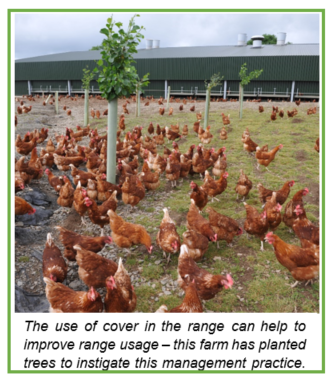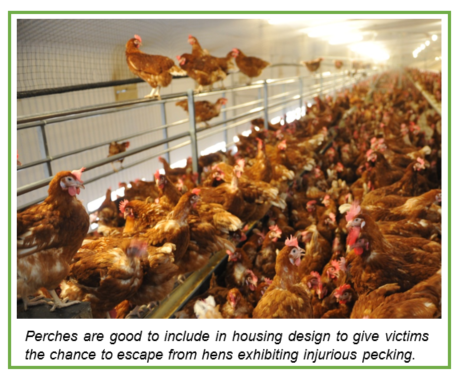Dr Ruth Wonfor: IBERS, Aberystwyth University
Take home messages:
- Injurious pecking is a behaviour that affects hen welfare in many free range systems, the current common control strategy is the use of beak trimming.
- Management strategies to improve foraging behaviour and enrichment of the hens’ environment can help to reduce injurious pecking in flocks.
- The rear to lay transition should also be managed with minimal stress for the bird to reduce uptake of injurious pecking.
- Using flock specific management packages will reduce injurious pecking and thus, may diminish the need for beak trimming.
Injurious pecking (IP) is a common welfare issue in free range flocks. Injurious pecking is an umbrella term which groups several pecking behaviours, ranging from the less severe gentle feather pecking, to the more severe cannibalistic pecking. The following behaviours are classified as IP: gentle and severe feather pecking, vent pecking and cannibalistic pecking. Severe feather pecking, vent pecking and cannibalistic pecking differ from gentle feather pecking in that they cause physical damage to the bird. The damage ranges from pulling out feathers, to pecking of the skin resulting in wounds and drawing blood and, in extreme cases, even pulling out inner organs via vent pecking. These behaviours are stressful and painful for the victims; they can ultimately increase mortality rate and disease susceptibility, make it more difficult for the hens to effectively thermoregulate, and reduce flock productivity. Although gentle feather pecking rarely leads to physical damage as only feather tips are pecked, the question remains as to why the birds are performing the behaviour; is there an underlying welfare issue that leads in birds feeling the need to peck? Injurious pecking in chicks is difficult to spot as chicks moult their feathers several times during the rearing phase. However, IP is known to be present during rearing and an effort should be made to prevent its development in order to reduce uptake of the behaviour in early life, which is harder to then eradicate in the laying phase.
Beak trimming is the main control measure used by the majority of free range systems to prevent the birds from performing feather pecking. Day old chicks are beak trimmed using infra-red technology. Several European countries, including the UK, have demonstrated an attempt to ban the use of beak trimming as a control measure, due to concerns over the welfare of the birds. The UK had aimed to ban beak trimming by January 2016, however, a government commissioned report from the Beak Trimming Action Group (BTAG) concluded that, until there is a successful alternative management strategy in place, national banning of beak trimming would lead to increased levels of IP. It was deemed that the consequences of such an outbreak would be more detrimental from an animal welfare point of view than infra-red trimming at 1 day old. The Government decided to postpone the introduction of the ban; this does however not mean that a beak trimming ban will never be introduced. There is still wide spread concern over the welfare implications of beak trimming, and as such, the layer industry must focus on ways to improve day to day flock management in an effort to prevent IP and consequently eliminate the need for beak trimming. In the organic sector, beak trimming is not allowed; a factor that can increase the prevalence of severe feather pecking in these systems. It is however worth noting that organic flocks are very different to commercial ones; for example the flocks are much smaller and the birds are stocked at a lower stocking density, all factors that can make feather pecking more manageable.
Injurious pecking is more common in free range systems compared to caged systems. Reasons for this include the fact that the birds performing the behaviour have access to more victims, and the fact that it is harder for the producers to identify which hens are the perpetrators and consequently being unable to remove them from the flock. One possible solution would be to move back to enriched caged systems, however, this is not feasible. Consumers deem the welfare of the birds to be better in free range systems and perceive the hens to be happier in such systems compared to caged systems. Furthermore, the majority of retailers in the UK have now pledged to move to cage-free production. Yet many consumers are unaware of the presence of IP in free range systems, and a recent survey showed that when made aware, 40% of consumers changed their perceptions of the system. Consumers reported that they would pay around 3.4% more for a dozen medium free range eggs in order to improve welfare in current free range systems. Thus, there is a clear need for the development and uptake of alterative management solutions in order to improve bird welfare and prevent IP in free range flocks.
Researchers have been working with farmers to investigate risk factors for feather pecking, and ways to manipulated those identified to reduce the prevalence of IP, aiming to make management strategies as easy to implement as possible. The cause of IP is multifactorial, and research has identified causative factors such as nutrition, genotype, light, stress, floor type and stocking density, amongst others. Injurious pecking is also an extension of foraging behaviours, and the inability to perform these instinctive behaviours can be a determining factor in the development of IP.
Access to a range gives hens the ability to forage and experience different environments, increasing
stimulation through preening, resting in the sheltered areas and dust bathing in the more open areas. Hens should be introduced to this as early as possible in life in order to maximise its use. However, the range is often not fully used by the hens, possibly due to a lack of natural and artificial cover. The hens benefit from the presence of natural (e.g. trees) and artificial (e.g. old trailers) cover for shelter and protection from potential predators. Studies have found that when cover is present, hens will range further from the house than when no cover is present. Interestingly, range cover has also been demonstrated to affect plumage damage – where more tree cover is present on a range, plumage damage in the flock is reduced compared to flocks with less tree cover. Furthermore, the range pasture should be well managed and rotated, not only for maintenance of the land, but also to improve foraging behaviour.
Housing should always be well designed reflecting good welfare, even if hens have access to a range. Use of perches reduces the prevalence of IP by giving victim birds an area to escape, as long as perches are above head height. In rearing houses, dark brooders are useful to allow chicks to rest in conditions that mimic resting under the mother’s plumage. This allows for some chicks to be active, and for others to access a rest area similar to natural conditions and in turns is shown to improve the feather cover of flocks. The floor type in loose-housed systems should also be considered. Raising hens on wire can lead to poor plumage scores, likely due to a lack of stimulus for foraging or dustbathing. Having access to straw during rearing has long been known to reduce feather pecking in flocks, more so than having access to sand or sawdust. Straw gives a deeper litter and encourages exploratory behaviours.
The hens’ diet also plays an important role, both for general production and also for its effect on IP. Diets high in protein and specifically amino acids, such as methionine, cysteine and lysine, are important for reducing IP. Furthermore, fibre is an essential dietary source. Insoluble fibres can be used to dilute energy in the diet, which increases the time spent feeding, as well as gut motility and subsequently, can reduce IP. Such diets should ideally be fed during rearing and laying to see the most benefit on IP management. The number of times a diet is changed should be minimised. If it is essential to change the diet, this should be completed gradually and extra enrichments should be provided to minimise stress. Rations can be provided through the form of mash or crumps – both improve foraging behaviour and decrease IP.
Stress factors that can arise due to the transfer from rearing to laying should also be minimised. The ideal scenario is to rear birds on the same farm that they will lay on, allowing a gradual transition and giving producers the ability to keep both environments similar. However, if this is not possible it is important for rearers and producers to communicate and to ensure that the rearing and laying environments are as similar as possible. Reducing the numbers of changes between the systems will reduce the stress of the transition, which in turn can help to reduce the development of IP. It is useful to introduce and habituate chicks to as many aspects of the laying house as possible; for example, the types of feeders and drinkers that will be used during lay, as well as perches, enrichments and providing access to a range.
As IP risk factors are multifactorial, management plans to reduce IP in flocks cannot be considered a ‘one size fits all’ approach. Bespoke plans are therefore needed for each flock, analysing any weaknesses within the system that may be contributing to the presence of IP, and developing targeted improvements. Such bespoke packages have been shown to reduce IP; the more management strategies utilised, the better the improvement. These strategies require a multifactorial approach and call for synergy between advisors, industry, vets, academics and most importantly, the producers themselves. Strategies should be accessible to the producer and easily implemented in order to reduce the impacts on time and finances.
The FeatherWel project, led by the University of Bristol, has produced a guide for laying hen farmers for improving feather cover, looking at both laying and rearing systems. View the guide for advice on easy to implement management strategies to reduce IP in your flock. Look out for poultry events through Farming Connect.


